When to use Complex mode
Use Complex mode to prepare a transfer when:
- selecting affected shares/interests
- describing part of the land
- adding text
- specifying a third-party transfer
- adding preset wording suffix to transferees.
Affected titles must have the same ownership and shares. See:
Dealing with titles with different ownership
Mandatory fields in the Prepare Transfer page are marked with a red asterisk and must be completed for successful pre-validation and submission.
Life estate titles
Transfers default to Complex mode if they are for Life estate titles.
A message will appear asking you to define which estate you'll dealing with in the Additional Clauses, Conditions, or intent field.
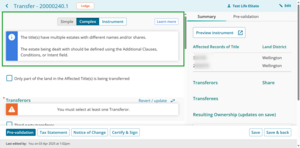
1: Navigate to the Prepare instrument page.
You access the Prepare transfer page from the Instruments & Roles page. To open the page, choose 1 of the following:
- Select the Transfer hyperlink when the instrument details are collapsed.
- Select Prepare when the transfer instrument details are displayed.
- Select the 3-dot menu, to the right of the transmission instrument. Then select Prepare instrument from the menu.
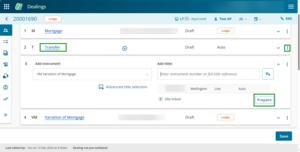
2: Select Complex to change to Complex mode.
By default, Simple mode is selected for a Transfer instrument. Select Complex to change to this mode.
Choose Complex mode:
- to deal with different shares or interests
- when dealing with only part of the land
- to add additional details such as text or images.
Prepare a transfer in Simple mode
Prepare a transfer in Instrument mode

3: Check Only part of the land in the Affected Title(s) is being transferred, if needed.
Select the Only part of the land in the Affected Title(s) is being transferred checkbox if the transfer is only for part of the land.
Enter the legal description for the part to be transferred. The Description of Part field is a free text field limited to 500 characters.
Make sure you include all the details required. For example: Part Lot 1 LT12345 formerly comprised in Lot 2 DP6789.
This instrument will step down to Lodge if this field is used.
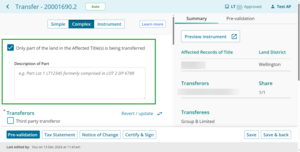
4: Check the Transferors are correct.
The registered owners will automatically display in the Transferor section.
The names may also reflect any change of ownership instrument that has been prepared in the same dealing, prior to the transfer.
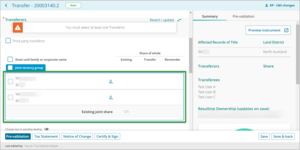
If needed, you can do the following actions with the registered owners:
- change due to pending dealing
- revert or update owner names
- view additional information for the owners.
Change due to pending dealing
The Change due to pending dealing toggle under the transferors can be used to edit, add or delete the names displayed. For example, use when an instrument in a prior dealing is updating who the transferors will be, or if dealing with protected (hidden) titles.
You will need to confirm you want to modify the names before making any changes.
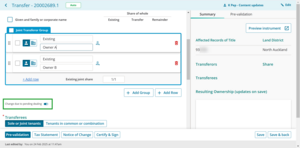
Revert/update
Use the Revert/update button above the Transferor section to re-set the transferor names to reflect the Register and any prior instruments in the dealing.
For example, if the name has been edited using Change due to pending dealing it will revert to what is recorded on the Register. Or, if a prior instrument has been added to your dealing which changes the transferor, using Revert/update will pull through the updated names.
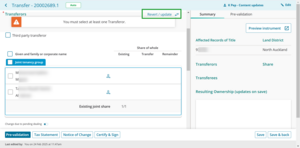
Additional details
To view other details such as an alias, suffix or birth date of a minor, select the person icon to the right of the transferor.
If the person icon is filled in blue there are additional details recorded for that transferor.
To add, edit or remove details, toggle on Change due to pending dealing, then select the person icon to make the changes.
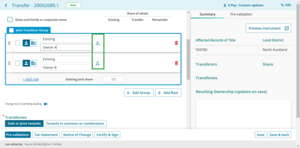
5: Add details for a third party, if involved in the transfer.
Skip this step and go to step 6, if no third party is involved in the transfer.
Check the Third party transferor checkbox if the transfer is on behalf of a third party. For example, the name of the Territorial Authority, for non-payment of rates.
Enter the name of the affected third party.
Select a reason from the Justification field.
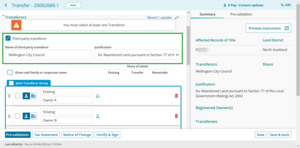
6: Select the owners affected by the transfer.
Select the checkbox to the left of a transferor to affect them as a part of the transfer.
To affect all owners in a group, select the checkbox next to Joint tenancy group.
To affect all transferors, select the checkbox next to the Given and family or corporate name heading.
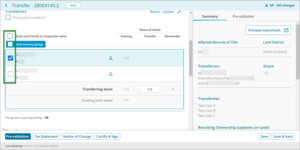
7: Review or change the share value to be transferred.
Review the Transferring Share. It pre-populates with the entire share of the party selected but can be edited if less than all is being transferred.
A calculator simplifies the fraction you enter, down to the lowest common denominator.
The remaining share, if any, is then calculated and displays in the Remainder column.
If the transferor is a joint tenant, transferring their share may break the joint tenancy.
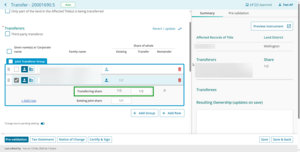
8: Select either Sole or joint tenants, or Tenants in Common or combination.
By default, Sole or Joint tenants is selected.
A sole tenant indicates only 1 transferee.
A joint tenancy can have 2 or more transferees.
Tenants in common relates to 2 or more transferees who hold their interest as to shares. For example, John holds a ¼ share and Jenny holds a ¾ share. Shares must total 1 whole share.
A combination ownership contains joint tenants and tenants in common. For example, Michael owns a ½ share and Rose and Brian are joint tenants as to the other ½ share, totalling 1 whole share.
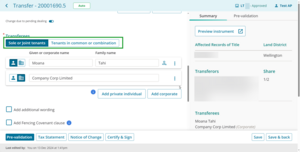
9: Enter the transferee name and any applicable shares.
Sole or joint tenancy
Enter a transferee name into the provided fields.
By default, individual fields are selected.
Select the corporate icon to add a corporate name.
Use the Add private individual or Add corporate buttons to add another transferee.
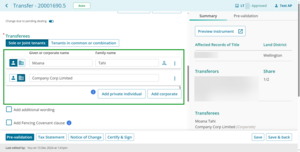
Tenants in common or combination options
Use Add group in the Tenants in common or combination mode to create a joint tenancy structure.
Use the Share field in the Tenants in common or combination mode to add the share value for each transferee or group. Use fractions with all shares that add up to 1 share.
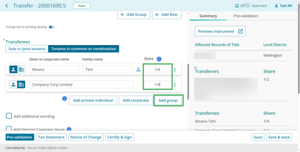
Add additional details
Use the person icon at the end of a transferee row to add:
- an alias
- suffix after a name, or
- birth date of minor (under 20 years old).
When you save, the person icon will change from an outline to solid. This functionality is not available for corporate entities.
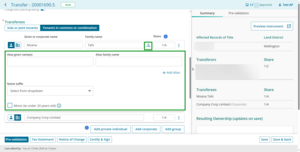
Three-dot menu
Use the 3-dot menu for options to:
- move transferees up or down
- create or add to a joint tenant’s group
- remove a transferee from a group
- delete a transferee row.
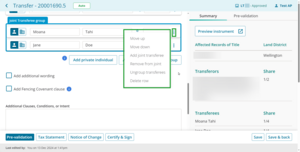
10: Select Add additional wording if needed.
Go to step 11 if additional wording is not required for the transfer.
Select the Add additional wording checkbox if you need to display more wording on the memorial for the title.
Select the relevant wording from the drop-down menu. The wording will be added to the end of the description of the transferee on the memorial for the title. For example, ‘No Survivorship’ or ‘as trustees under the provisions of the Methodist Model Deed of New Zealand 1887'.
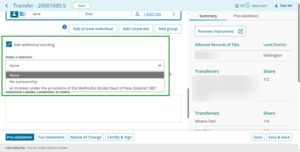
11: Select the fencing covenant checkbox, if needed.
If a fencing covenant is required, check the Add Fencing Covenant clause checkbox. Otherwise leave it unchecked.
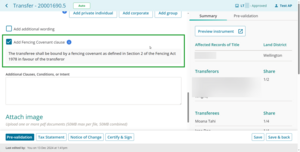
12: Add text to the Additional Clauses, Conditions, or Intent field, if needed.
Skip this step and go to Step 13 if you don’t need to add text to support the transfer.
Use the Additional Clauses, Conditions, or Intent field to include additional details, such as supplementary clauses or conditions or to clarify the intent for the transfer. This is a free text field.
Make sure you include all the details required.
For example:
- define the estate being dealt with when there are multiple estates on the affected titles with different names or shares, or
- use this field to combine the shares of an owner or owners.
This instrument will step down to Lodge if used.
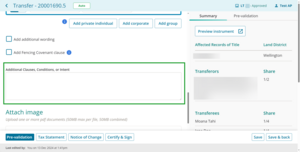
13: Upload an attachment to support the transfer, if needed.
Skip this step and go to Step 14 if you’re not uploading supporting documents.
Use the Attach image field to add PDFs. You can:
- drag and drop a PDF into the Attach image field, or
- select browse and upload a PDF from your files.
Each file must be under 45 MB in size and all attachments combined must not exceed 45 MB. You won’t be able to save the Prepare instrument page if any or all attachments exceed 45 MB.
Delete 1 or more attachments until the combined size is 45 MB or less.
You can view the attached PDF:
- by clicking on the PDF, or
- selecting Preview Instrument to view the compiled instruments and attachments.
Attaching an image will cause the instrument to step down to Lodge.
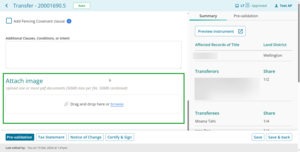
14: Review the Summary and preview the instrument.
The Summary tab will automatically update key details entered on the left-hand side of the page.
The Resulting ownership will only update when saving the page. A pie chart visually represents the shares or interests for each resulting owner. Hover your mouse over a pie chart segment to highlight the affected resulting owner.
Select Preview instrument to view, print or download the full Instrument preview, including any added text, attachments or certifications and signatures.
The Instrument preview might take time to load if you have attached PDFs. It needs to compile the structured data with the attachments.
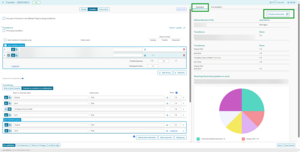
15: Save.
Select Save at the bottom right of the page to save the information and stay on the Prepare instrument page.
Select Save & back to save the information and return to the Instrument & Roles page.